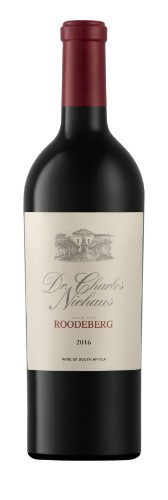Dr Charles Niehaus, the top tier signature red wine launched in 2011 as a tribute to Roodeberg’s illustrious founder, represents the best of the best.
Fruit purity and complexity are the crux of this super-premium Roodeberg that has evolved since its maiden vintage in 2010 into a formidable Shiraz and Cabernet Sauvignon driven blend.
The wine was launched as the jewel in the Roodeberg crown to honour Dr Niehaus for his pioneering winemaking achievements and creator of this cherished South African wine brand that celebrates its 70th anniversary this year. Dr Niehaus was the successor of Dr Abraham Izak Perold, the KWV’s chief wine scientist and revered father of Pinotage. Inspired by a glorious sunset over the Paarl mountains, the name, Roodeberg, harks back to the vineyards of Rothenberg near Geisenheim in Germany where Dr Niehaus studied winemaking. He retired in 1971 leaving a rich legacy of winemaking prowess in his wake.

The evolution of the Dr Charles Niehaus blend into a superbly concentrated and integrated wine can be attributed to constant experimentation with different grape varieties and different regions over the past eight years.
“The wine is all about selecting the best of the best from the vineyards, the individual bunches and the berries, down to the finest barrels for the final blend. Our goal is to produce the best super-premium blend that our vineyards can deliver,” says Roodeberg winemaker Louwritz Louw.
When it comes to stylistic evolution, the winemaking team has one goal in mind – the wine needs to be complete. The style of the more recent vintages is bold, with fruit complexity and hints of sweetness supported by superbly balanced oak integration that complements the varietal expression.
“It’s all about meticulous selection and understanding the varieties and regions we work with. We will keep pushing the boundaries to produce even higher quality wines,” assures Louw.
Each variety brings something unique to the blend resulting in a wine of exceptional fruit concentration, structure and finesse. What started out as a blend of three varieties, namely Shiraz, Cabernet Sauvignon and Merlot in the maiden 2010 vintage, evolved over the next three to four years to more complex blends incorporating a range of different varieties such as Petit Verdot and Malbec.
“Stylistically, the wine started to change into a more bold and beautiful blend and by 2013, Shiraz and Cabernet Sauvignon had become firmly rooted as the dominant varieties,” adds Louw.
Vineyard site selection is an important cornerstone of the blend and the winemaking team has identified “Dr Charles” vineyards that produce concentrated fruit in areas such as Stellenbosch, Paarl, Swartland and Darling.
Over the years interesting varieties such as Tannat and Petite Sirah have found their way into individual vintages and Cabernet Franc has been included in the yet to be released 2017 vintage.
“Each year we select the most promising niche varieties to polish and add the final touches to the blend,” explains Louw.
While vineyards and grape varieties may change somewhat from year to year, the Shiraz and Cabernet Sauvignon character remains constant, as does the use of French (85%) and American (15%) oak for barrel maturation.
In the awards stakes, the Dr Charles Niehaus blend has garnered some impressive local and international accolades. Earlier this year, the 2016 vintage struck Gold at the Sakura Japan Women’s Wine Awards, while the 2012 was a Gold medallist at the Sommelier Wines Awards in London.
At home, the 2014 vintage was awarded Double Gold by the Michelangelo International Wine Awards, and the 2013, 2014 and 2015 vintages all hold Veritas Gold medals.
The current 2016 vintage is a blend of Shiraz (38%), Cabernet Sauvignon (32%), Merlot (20%) and Malbec (10%). Juicy and concentrated with great depth, it erupts in your glass with aromatic layers of blackberry and plum enlivened by hints of violets, dark chocolate and white pepper. The wine is generous and well-integrated on the palate with a firm tannin structure rewarding with a smooth and lingering finish.




